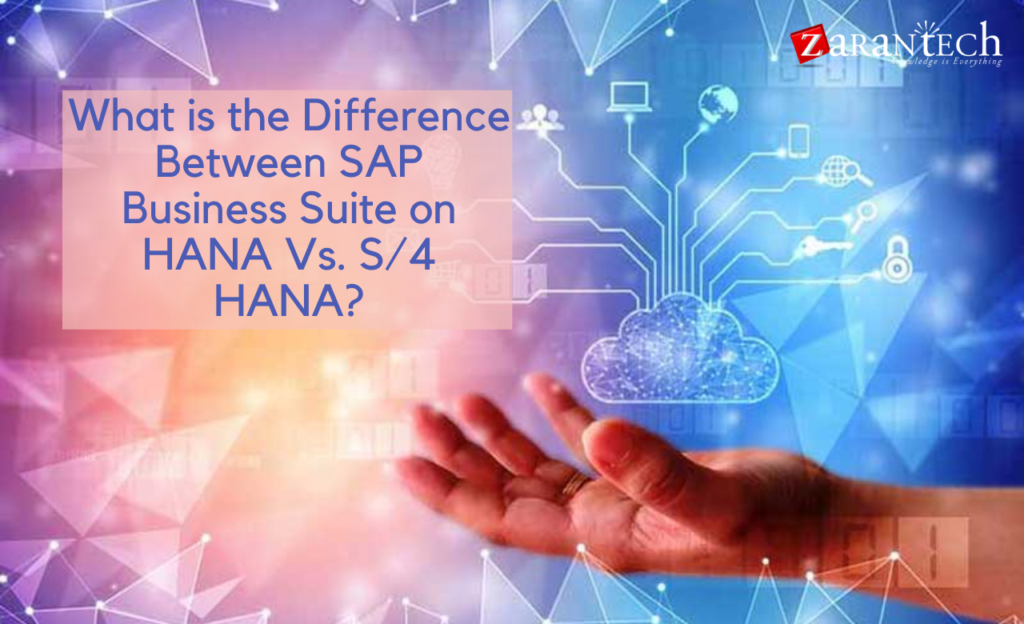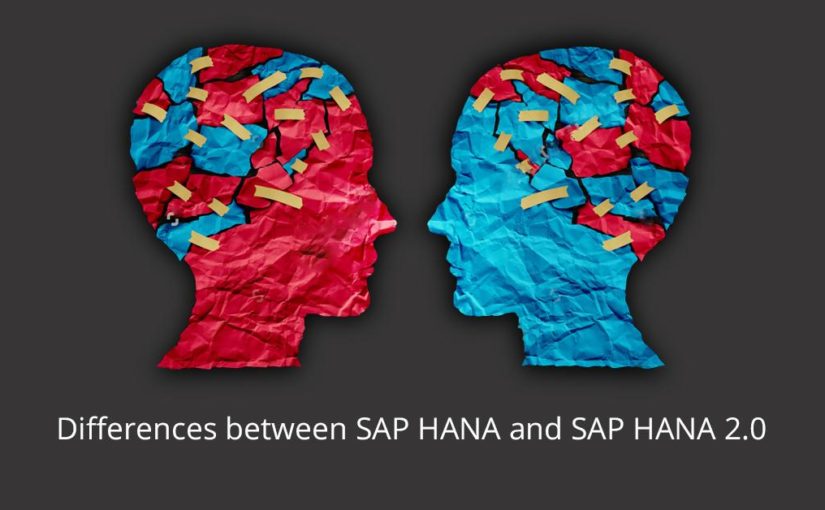What is the Difference Between SAP Business Suite on HANA Vs. S/4 HANA?
Category: SAP HANA, SAP S/4HANA Posted:May 13, 2020 By: Alvera Anto
When SAP released its high-performing SAP HANA in-memory database and platform in 2011, this move made a significant change in the business’s product technique. SAP had not previously offered its own database. Its items were database agnostic, but that was all changing. Today, SAP fields both SAP HANA as well as S/4HANA, which is SAP’s next-generation business suite for ERP and also even more. As its name suggests, S/4HANA runs on SAP HANA and only on SAP HANA. It does not support Microsoft SQL Server, IBM DB2, etc. In early 2025, SAP will stop supporting all business applications apart from S/4HANA. This looming target date provides two migration challenges. A company should adopt SAP HANA as its database and also migrate from ECC to S/4HANA. This dual migration can be a bit daunting. However, an intermediate move is available. It is possible to run ECC on top of the SAP HANA database. This is often referred to as “Suite on HANA” or simply “SoH.” There are some advantages and disadvantages to this technique, which we will go over when checking out SAP Business Suite on HANA vs S/4HANA.
Difference between SAP ECC, SAP HANA, and S/4HANA?
To recognize how SAP ECC, SAP HANA, as well as S/4HANA, vary, it is very important to know that SAP HANA is actually more than just a database. It’s the back-end that runs the SAP landscape. That stated, SAP HANA does not execute business transactions. That requires SAP applications that run on top of HANA, e.g. Finance, Human Resources, and Logistics.
- SAP ECC is an enterprise suite that comprises ERP Modules like logistics, warehousing, finance, and also personnel. ECC overlaps with SAP R/3 as well as SAP ERP. This can create some complications. To clear up, ECC evolved from SAP R/3, which was first released in the early 1990s. In 2003, the application came to be referred to as “SAP ERP.” By 2004 on, the term “SAP ECC” was used more or less interchangeably with “SAP ERP.” To keep the discussion on track, we’ll refer to any of these applications as “SAP ECC.”
- SAP HANA is the backend that runs the SAP landscape. Its central attribute is an innovative, column-based Relational Database Management System (RDBMS), which is used to save, obtain, and process data on core business activities. SAP HANA itself doesn’t determine what sorts of tasks a business does, it can fit any kind of data. Businesses install applications that run on top of HANA, such as SAP applications for Finance, HR, and Logistics. Thus, businesses have to choose what software best meets their present requirements.
- SAP S/4HANA is SAP’s next-generation business suite, created particularly to collaborate with SAP HANA. S/4HANA is an ongoing project, with SAP now reworking the code behind the SAP ECC modules and optimizing them for the way the HANA database is set up. To date, SAP has actually reworked the Finance Module and boosted logistics as part of the core S/4HANA features. In other areas, work has yet to be done to make business advantages of SAP Business Suite on HANA vs S/4HANA much more considerable.
Want to Boost Your Career? Click Here
SAP S/4HANA’S ADVANTAGES OVER ECC
User responses have been positive for SAP S/4HANA, with many impressed by the application’s simplifications to the data model, user experience, decision making, business processes as well as model. S/4HANA brings much-needed developments for IoT, “Big Data” analytics, mobility, and more. S/4HANA also uses the Modern Fiori User Experience (UX). Fiori UX provides customers a more intuitive and reliable UX compared to the older SAP GUI. Other advantages include:
- Financial Management and Accounting
SAP S/4HANA Finance covers the complete range of finance tasks, which extend planning, analysis, accounting, compliance, and Risk Management. ECC does not provide all of this functionality in one application, making it less reliable. According to SAP Chairman, Hasso Plattner, the S/4HANA finance application can shrink data more than 10 fold, from 593 GB to 42 GB, “with just 8.4 GB being dynamic, current-year data needing high accessibility as well as backups.”
- Rapid Data Modeling
Because SAP S/4HANA does away with the supporting data, it can also eliminate the rigid structures. You can rapidly build models, predicting the impacts of company choices such as divestment or acquisition. This flexibility permits predictive modeling, real-time cost as well as profit analysis, and also cash flow optimization.
- Compliance and Monitoring financials
By centralizing data and eliminating repetitive info, S/4HANA makes it less complicated to stay compliant as well as monitor financials. Organizations aren’t forced to wait till the next close to getting an in-depth look at financial KPIs. They can assess data in real-time over any range and at the desired depth, which provides better insight into the wellness of the firm. SAP S/4HANA Finance also allows companies to automate threat, compliance, global trade, and various other activities. By proactively lessening threats and also compliance violations, the software makes it less complicated to maximize business operations, protect assets, and also boost financial efficiency. S/4HANA also offers real-time fraudulence detection. It can also anticipate as well as obstruct future fraudulent behavior.
- Supply Chain
S/4HANA provides compelling advantages over ECC in a variety of logistics uses, consisting of sales and procurement, Inventory Management as well as capacity planning. SAP S/4HANA enables real-time tracking of current inventory, transportation of goods, production costs, and other data. Accounting instantly reflects costs as well as revenues which provides better visibility into the firm’s current finance.
- Logistics
S/4HANA logistics can synchronize with mobile devices in specific trucks, automating invoicing and route preparation and publishing problems such as missing goods. It also analyses the circulation of items to reduce bottlenecks and help materials planners reduce inventory levels.
What Is a Business Suite on HANA?
Suite on HANA is more than simply using the SAP HANA database to support ECC. SoH puts ECC on the innovative SAP HANA backside system. Because of this, you obtain the performance boost of SAP HANA without restructuring the application layer. Individuals don’t need to adapt to a new system. Business Collection Suite faster on SAP HANA due to the fact that it’s working inside the memory element. The ECC functionality is the same as you would get on another database and hard disk drive data storage space. The majority of the SAP transaction codes are available in SoH. However, there is no data simplification. At the same time, accessibility to the HANA live studio lets you report in real-time. SoH also features amended transactions that deliver boosted performance.
Suite on HANA Data Structure and Architecture
The SAP HANA Platform is multi-tiered, facing front with a web server. The web server supports ECC applications along with cloud applications, IoT, mobile, APIs, etc. JavaScript, SQL scripts, and SQL code underlies the webserver. This layer, consequently, fronts the database itself. The SAP HANA database is a column-based Relational Database Management System (RDBMS). This columnar design allows HANA to do certain procedures much more rapidly than a standard database. Instances include Online Transaction processing (OLTP) and Online Analytical Processing (OLAP).
Suite on HANA Migration
SAP will remain to support and update Suite on HANA, giving you the flexibility to plan your SAP HANA migration and S/4 upgrade in a way that makes sense. Good planning can optimize strategic benefits while minimizing disturbances. The roadmap to Suite on HANA is quite basic. You are required to update to ECC6 Enhancement Pack 7 and then execute a database migration from your current database to HANA. This is generally a technical exercise as well as achieved effortlessly with a strong technical partner.
ECC individuals may migrate to SAP Business Suite on HANA initially, or upgrade directly to S/4HANA. The database and tables will have to be converted into the columnar structure of SAP HANA, with unneeded indices as well as accumulated tables eliminated. In addition, applications created or customized by the customer must be examined. In some cases, new HANA functionality may make them unneeded, while in other instances, they need to be adjusted to work effectively with the new backend.
Installing either SAP Business Suite on HANA vs S/4HANA requires modification at the backend. SAP HANA has the ability to sustain all ECC functionality, but the various structure of the database necessitates excellent SAP Basis support, plenty of testing as well as backups, and potentially some post-go-live tweaking to ensure whatever is functioning effectively.
If your company has custom applications, legacy servers, or multiple environments, it can additionally make complex things. An SAP partner with considerable SAP HANA migration experience can assist you in intent the most effective method to adapt complex or custom ERP environments to HANA. In most cases, HANA functionality can get rid of the demand to use custom code.
All the same, companies will certainly need to update NetWeaver, change and tweak the new applications, and provide some additional training utilizing S/4HANA applications and updates. The business may also gain from maximizing their ERP landscape (for instance, by merging several SAP HANA Company Suite systems or migrating legacy systems to HANA), which includes extra complexity to the projects.
Want to Enhance Your Skills? Click Here
Sizing the Environment with Expertise
It is very important to note that not appropriately sizing the hardware before your migration will result in poor response times as well as generally poor system performance. The SAP Quick Sizer device is a great beginning factor; yet, one needs to still analyze the rise from the Quick Sizer and make additional calculations to genuinely lockdown the correct hardware configuration.
At Proportion, we have years of expertise in right-sizing the landscape. We can review the SAP ecosystem amongst companies of all sizes and also within all industries for the following elements:
- KPIs for peak and average loads.
- Disk requirements.
- Usage details for application deployments.
- As well as numerous other KPIs, including those for database startup times, input/output efficiency, data throughput as well as storage system latency.
Making the Choice
Every company is unique, so the path to S/4HANA relies on your detailed demands. For many SAP ECC individuals, they prefer to begin with SAP Business Suite and move to S/4HANA at a later date. SoH supplies numerous crucial benefits of S/4HANA and is simpler, more economical, and less turbulent. Highly dynamic companies may desire the benefits of S/4HANA enough to do the full S/4HANA upgrade all at once.
For firms upgrading from a legacy or non-SAP system, we recommend going straight to SAP S/4HANA They’ll be developing as well as migrating to a totally new system anyhow, so there are no benefits to moving to SAP Business Suite on HANA. For firms with a complicated mix of SAP ECC and other ERP environments, however, the selection can be more intricate, and a multi-phase task might make one of the most sense. This is a typical migration plan for those who call for production applications support throughout a migration. It’s inexpensive while also supporting the use cases and also functions most critical to organizational performance.
Your firm’s perspective towards the cloud as well as IT infrastructure upgrades is additionally a factor. If your company hesitates to handle big IT tasks, moving straight from SAP ECC to S/4HANA may make one of the most sense. Despite the included complexity, at the very least you’re done in one fell swoop.
Getting the Most Out of S/4HANA
When it concerns migrating to ERP on HANA, the right business partner can make all the difference. From choosing between SAP Business Suite on HANA vs S/4HANA to planning and executing your SAP HANA migration to tweaking as well as running your SAP HANA Cloud post-go-live, we can take full advantage of the advantages of your SAP investment, while lessening prices and disruptions.
Conclusion
SAP HANA does not execute business transactions. That requires SAP applications that run on top of HANA while SAP S/4HANA is SAP’s next-generation business suite, created particularly to collaborate with SAP HANA.
If you are planning to boost your skills, choose our best online training platform, and learn from industry experts. So what are you waiting for? Click here, to skyrocket your career with the unique learning needs because Learning Never Exhausts The Mind.




 99999999 (Toll Free)
99999999 (Toll Free)  +91 9999999
+91 9999999